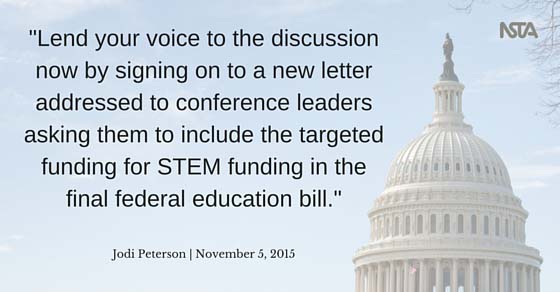Let Your Voice Be Heard–Support STEM Education in Final No Child Left Behind Bill
By Jodi Peterson
Posted on 2015-11-05
Hopes mount that Congress will complete reauthorization of No Child Left Behind this fall, establishing the federal funding and programs that will help to define K-12 education for the next several years.
House and Senate education leaders and their staff are continuing their work to reconcile the differences in their respective bills (H.R. 5 and S. 1177). Lend your voice to the discussion now by signing on to a new letter addressed to conference leaders asking them to include the targeted funding for STEM funding in the final federal education bill.
We are seeking organizational (not individual) sign-on for the letter, which is below or read it here. If your organization or school/district/business can sign on to this letter, or if you have questions, please e-mail me at jpeterson@nsta.org. The letter will close on Friday, November 13. Please feel free to share this information with your networks in the state and district. Thank you.
Jodi Peterson is Assistant Executive Director of Legislative Affairs for the National Science Teachers Association (NSTA) and Chair of the STEM Education Coalition. e-mail Jodi at jpeterson@nsta.org; follow her on Twitter at @stemedadvocate.
Dear Chairman Alexander, Ranking Member Murray, Chairman Kline, and Ranking Member Scott:
As you and your staff work to reach agreement on the legislation to reauthorize the Elementary and Secondary Education Act (ESEA),we urge you to include a provision of the Every Child Achieves Act (S. 1177, Title II.E) that would provide targeted funding to each state for science, technology, engineering, and mathematics (STEM) related activities.
In recent weeks, more than 50 members of the House and Senate from both parties have also written to you in united support of making STEM education a priority within the final legislation agreement and have similarly urged the inclusion of Title II.E in the conference agreement.
This key STEM education provision would provide formula grants to the states, which then administer grants to partnerships between schools, businesses, non-profits and institutions of higher education. These state-based partners would have broad discretion under the language of the provision to decide how to best use resources to improve teaching and learning in STEM subjects. Funding would support a wide range of STEM-focused objectives including recruitment, retention, and professional development of educators. Additionally, the provision would expand learning both in and outside the classroom, support STEM-related competitions and other forms of hands-on-learning, and improve student academic achievement in the STEM areas for underserved groups.
Title II.E is not a new program. Instead, it improves upon the existing Math and Science Partnership program at the Department of Education, which has a demonstrably positive impact on nearly 2.4 million students and thousands of educators every year. The STEM funding provision is also not duplicative of STEM programs at other federal agencies. The Title II.E provision would be the only education program—at the Department of Education or any other federal agency—providing direct formula-based funding to every state for the exclusive purpose of supporting STEM-related learning.
Federal investments in STEM education are critical in helping states to prepare our students for the challenges of today’s increasingly competitive world. If we are going to empower our students to compete in the global economy we must maintain a strong federal commitment to improve teaching and learning in the critical STEM fields. It is both appropriate and essential for the nation’s most prominent education law to establish STEM education as a critical priority.
Respectfully,
National Science Teachers Association
STEM Education Coalition
Disclaimer: The views expressed in this blog post are those of the author(s) and do not necessarily reflect the official position of the National Science Teaching Association (NSTA).



